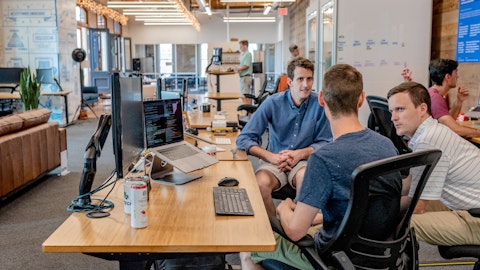Janesh Moorjani: Yes, as I said overall, we saw pretty good strength in terms of commitments that customers have made to us that’s broad-based, it’s for GenAI-specific workloads and Ash provided a couple of examples of those in his prepared remarks. And for the – more broadly for our overall business as well. So, we felt pretty good about that.
Yitchuin Wong: Makes sense. Alright. Thank you.
Janesh Moorjani: Thank you.
Operator: The next question is from Kash Rangan with Goldman Sachs. Please go ahead.
Kash Rangan: Hi, thank you so much. Happy holidays and congratulations on the quarter. On this GenAI thing, curious to get your updated thoughts, Ash, on how – what’s the Monetization strategy for GenAI? At one level, looking at the compelling explanation that you have, it makes Elastic more accessible, so it’s easy to start to use the system using natural language search. So, ESQL becomes a lot more accessible. Or is the market with GenAI opening up brand new use cases? Is it, one, where the accessibility of the platform just gets better so the monetization of the TAM becomes easier? Or is it that and new use cases that you could not otherwise target with the existing Elastic architecture that opens up more avenues, which is the right way to think about what is incremental opportunity and how do you put a price tag on your generative AI efforts? Thank you so much. Two questions there.
Ashutosh Kulkarni: Yes, Kash. Thank s for the question. And, you know, and let me first address the use cases, and then I’ll get to the monetization. So, if you think about the use cases, I’d break it into two categories. So, one is for search, and in the area of search, what we are seeing is generative AI is really broadening the TAM. There are lots of things that were not possible or were not easy in the past that now suddenly become both possible and, you know, relatively, you know, capable of implementation. So, one example would be video search or image search at scale. You know, that’s the kind of stuff that works incredibly well with vector search and hybrid search, but not so much with, you know, traditional just lexical search.
Another example is the fact that, you know, when you think about the kinds of customer service examples or the kinds of customer service use cases that people are trying to build with GenAI, these are experiences that just would not be possible with just search in the past. And now with the combination of semantic search and hybrid search, now you can build these conversational kinds of applications to improve the overall search experience. And that’s driving interest and in the future and even now, implementations that we believe are really, really exciting. So, it’s going to open up the TAM in the long term. How much? You know, it’s I think, TBD. We’ll get a better sense as we progress through the quarters and the years on just how much of an expansion of the search TAM gets created by this bao wave of generative AI.
Then when you think about security and observability in that area, I don’t think it’s as much of the TAM increasing, but rather. Generative AI, making it easier both for newer types of users to use the Elastic platform to solve observability and security use cases. And it also allows us to differentiate our platform a lot better, because now we can we can make it easier for customers to use the Elastic platform. And you know we’ve talked about this, we have a very strong focus on just improving the overall usability of our platform and generative AI is just making that much better. And then in terms of monetization, what I’ll what I’ll remind you is you know anytime you are using as Ray. You are fundamentally using the machine-learning capabilities on our platform, which are in our paid Platinum tier.
And then our AI assistance for observability and security. Our only available at our enterprise tier. And also these jobs – these machine-learning jobs for generative AI did tend to be a lot more compute-intensive, so there are various different vectors for us to monetize the work that we’re doing.
Kash Rangan: Amazing. Thank you so much once again. Congrats for the quarter.
Operator: The next question is from Koji Ikeda with Bank of America Securities. Please go ahead.
Koji Ikeda: Hi, guys, thanks for taking the question. I wanted to ask a question on Opster acquisition. You know, two parts here. Could you give us a sense of maybe the revenue scale and cash used for the acquisition? And then a little bit more strategically? When looking at the Opster website, you know, I saw things such as cluster health visibility, and improving the search performance. But I also saw that Opster helps reduce hardware cost, which sounds like it could be a little bit cannibalistic in a sense. So how should we be thinking about the long-term strategy for Opster from a monetization standpoint?
Janesh Moorjani: Hi, Koji, maybe we can take those in reverse order. Ash, maybe you can touch on the strategy first and then I’ll touch on the financials.
Ashutosh Kulkarni: Yes. So, when you – Koji, by the way, great question. So, you know, I’m super excited about the Opster acquisition. Like you said, what AutoOps really lets you do is, it lets you both monitor and manage the overall system, the cluster, and optimize it, right? Make sure that it’s running in the best way possible. It’s able to reduce and detect issues before they happen. So you’re able to make sure that, you’re able to have the system stay healthy at massive scale, which is very, very important for our customers. And that’s something that drives customer satisfaction. It’s something that, you know, encourages customers to then do more with our platform and drive more consumption. So it’s really a play around consumption to ensure that customers are able to do more with our platform and keep consuming in a way that is good for them and is good for us.
Now, your point about optimizing the hardware look, that is something that we believe is also a key part of our strategy in general, because the way we monetize is, we monetize by having a lot of these capabilities in our paid tiers and in cloud. And through that, it drives customers to adopt both higher tiers and also to adopt Elastic cloud. And we want our customers to constantly be spending less on infrastructure, but we monetize all of that by having them move to higher tiers because of which their spend on Elastic increases. So we believe that it’s a win-win for customers, it’s a win-win for us. And that’s what makes this such a compelling proposition.
Janesh Moorjani: And Koji, in terms of size, Opster is a small, but mighty team. And in terms of revenue, we’re not expecting any meaningful revenue contribution from Opster. As Ash described, the intent is really to fold the Opster technology into the broader Elastic Stack. And even in terms of expenses, we’ve just built that into the model that we’ve already provided.
Koji Ikeda: Got it. Super helpful. Thanks guys. Thanks for taking the question.
Janesh Moorjani: Thank you.
Operator: The next question is from Rob Owens with Piper Sandler. Please go ahead.
Rob Owens: Great. Thanks for taking my question. I was hoping you guys could drill down a bit on the security market and specifically SIEM applications as we’re starting to hear from others of a SIEM replacement cycle? Thanks.




